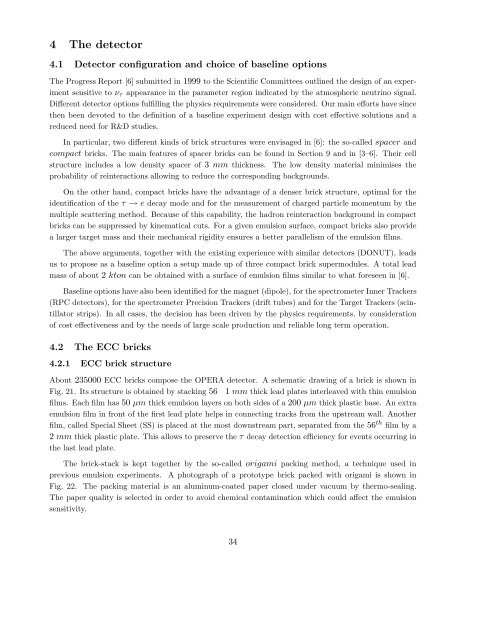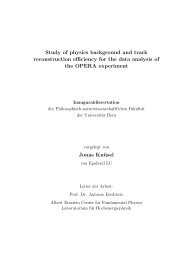Experiment Proposal - opera - Infn
Experiment Proposal - opera - Infn
Experiment Proposal - opera - Infn
Create successful ePaper yourself
Turn your PDF publications into a flip-book with our unique Google optimized e-Paper software.
4 The detector<br />
4.1 Detector configuration and choice of baseline options<br />
The Progress Report [6] submitted in 1999 to the Scientific Committees outlined the design of an experiment<br />
sensitive to ν τ appearance in the parameter region indicated by the atmospheric neutrino signal.<br />
Different detector options fulfilling the physics requirements were considered. Our main efforts have since<br />
then been devoted to the definition of a baseline experiment design with cost effective solutions and a<br />
reduced need for R&D studies.<br />
In particular, two different kinds of brick structures were envisaged in [6]: the so-called spacer and<br />
compact bricks. The main features of spacer bricks can be found in Section 9 and in [3–6]. Their cell<br />
structure includes a low density spacer of 3 mm thickness. The low density material minimises the<br />
probability of reinteractions allowing to reduce the corresponding backgrounds.<br />
On the other hand, compact bricks have the advantage of a denser brick structure, optimal for the<br />
identification of the τ → e decay mode and for the measurement of charged particle momentum by the<br />
multiple scattering method. Because of this capability, the hadron reinteraction background in compact<br />
bricks can be suppressed by kinematical cuts. For a given emulsion surface, compact bricks also provide<br />
a larger target mass and their mechanical rigidity ensures a better parallelism of the emulsion films.<br />
The above arguments, together with the existing experience with similar detectors (DONUT), leads<br />
us to propose as a baseline option a setup made up of three compact brick supermodules. A total lead<br />
mass of about 2 kton can be obtained with a surface of emulsion films similar to what foreseen in [6].<br />
Baseline options have also been identified for the magnet (dipole), for the spectrometer Inner Trackers<br />
(RPC detectors), for the spectrometer Precision Trackers (drift tubes) and for the Target Trackers (scintillator<br />
strips). In all cases, the decision has been driven by the physics requirements, by consideration<br />
of cost effectiveness and by the needs of large scale production and reliable long term <strong>opera</strong>tion.<br />
4.2 The ECC bricks<br />
4.2.1 ECC brick structure<br />
About 235000 ECC bricks compose the OPERA detector. A schematic drawing of a brick is shown in<br />
Fig. 21. Its structure is obtained by stacking 56 1 mm thick lead plates interleaved with thin emulsion<br />
films. Each film has 50 µm thick emulsion layers on both sides of a 200 µm thick plastic base. An extra<br />
emulsion film in front of the first lead plate helps in connecting tracks from the upstream wall. Another<br />
film, called Special Sheet (SS) is placed at the most downstream part, separated from the 56 th film by a<br />
2 mm thick plastic plate. This allows to preserve the τ decay detection efficiency for events occurring in<br />
the last lead plate.<br />
The brick-stack is kept together by the so-called origami packing method, a technique used in<br />
previous emulsion experiments. A photograph of a prototype brick packed with origami is shown in<br />
Fig. 22. The packing material is an aluminum-coated paper closed under vacuum by thermo-sealing.<br />
The paper quality is selected in order to avoid chemical contamination which could affect the emulsion<br />
sensitivity.<br />
34




